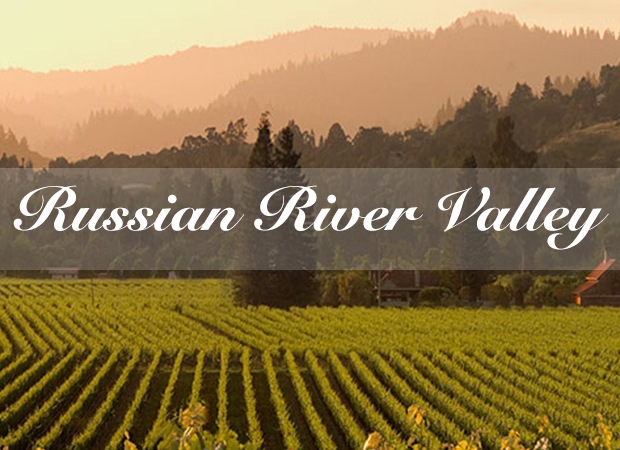Making sense of the Russian River Valley
The Russian River Valley AVA’s subregions create wines with subtle nuances that, according to local winemakers, make a world of difference.
The Russian River Valley Winegrowers have begun to explore the various terroirs that define the 150 square miles of the Russian River Valley American Viticulture Area (AVA). In the 30 years since the AVA was established, growers and winemakers have referred to areas of the Russian River Valley as having distinctive characteristics. The wine-drinking world agrees that the Russian River Valley is a large and diverse AVA distinguished by its quality. Thorough and methodical efforts to define terroirs will enhance this reputation, educating the public in the uniqueness of the neighborhoods and encourage wine drinkers to explore.
A highly regarded community of winegrowers and winemakers study what the region has to offer and share their findings with the wine-drinking community in an open and substantive way. Winemakers and growers from across the Russian River Valley are recognized experts capable of distinguishing between characteristics derived from the fruit and characteristics derived from winemaking techniques. Their efforts will focus on traits that consumers can identify in the glass and will avoid categorizations like “favorite” or “best.” Their analysis will begin with Pinot Noir, but they will explore other varietals that have made the AVA famous. They speak as one AVA now and their neighborhoods will contine to be exactly that – smaller communities with interesting and individual characteristics in the highly regarded Russian River Valley AVA.
With approximately 16,000 acres of grapes, the Russian River Valley is comprised of many small vineyards. It’s been an American Viticultural Area (AVA) since 1983, with expansions in 2005 and 2011. Are the nuances imparted by the various subregions recognizable? Most of the local winemakers think so. "At the most basic level, we all know winemakers and people who love Russian River Valley think they recognize differences in wines from among the different sites. Using Pinot Noir from the 2014 vintage, they are trying to ascertain if ‘specific’, consistently identifiable sensory characteristics derive from grapes grown in the different neighborhoods."
The Neighborhoods
Middle Reach
The Middle Reach is the northernmost neighborhood, closest to Healdsburg and Dry Creek Valley and is anchored by the wineries and vineyards along Westside Road. Among these are Alysian, J. Rochioli Vineyard and Winery, Bacigalupi Vineyards, Flax Vineyard (of Merry Edwards Winery), Bucher Vineyard, Allen Vineyard and Williams Selyem Estate Vineyards. It’s also home to many of the appellation’s oldest plantings, where the aromatics are less defined. Instead, the wines are about texture and length, and they tend to be broad and expansive on the palate. Acidity is not the defining feature.
Fog brought in by the Russian River, which snakes through the heart of the neighborhood, keeps temperatures cool enough to grow Pinot Noir. During the day the warmth here tends to develop Pinots that are dark, meaty and built to last. They display firm tannic structure, but also a lushness that keeps them soft. These wines tend to be ripe and full bodied. Also the proximity to the physical river is key. It’s a different water influence than the Laguna de Santa Rosa.
The fog is densest in summer, allowing grapes to retain acidity at ripening. It’s not exceptionally hot, the sugars don’t go up too much, but flavors have time to develop. Wines get cola spice, dark fruit; they are earthier, darker and richer, with lusher notes on the palate, and an acid backbone. The wines are not vegetative and there’s more ripening in the seeds. Wineries in this area include Armida, Rochioli, Williams-Selyem, Arista and Bucher.
Key facts on Middle Reach:
Historic area planted in the 60’s
Fog touches it later in the day and leaves earlier
It is a warmer microclimate, 10-15% warmer than the other neighborhood
The soil temperatures are warmer-note soil temperatures and soil dryness are what starts harvest-early ripening
The tannins are super polished
The pH is higher so many of the wineries use whole cluster and stems (except Arista-completely destemmed)
Laguna Ridge
South of the Middle Reach near Forestville, a narrow strip blessed by deep, well-draining sandy Goldridge and Altamont soils, with some Franciscan at its northern end, is the Laguna Ridge, sometimes called the Golden Triangle. It overlooks the Laguna de Santa Rosa, where water pools during winter rains.
Wineries in the Laguna Ridge include Merry Edwards, Dehlinger Winery, Lynmar Estate, Kistler and Joseph Swan Vineyards. Swan was the first to plant Pinot Noir in the Laguna Ridge after Prohibition on the advice of Andre Tchelistcheff, who referred to it as “middle-cool".
The Pinot Noirs have a wonderful mouth feel and moderate acidity, going from red to dark fruit, strawberry, mixed berry, pit-like fruits like plum and nectarine, with a brambly, exotic spice character. The wines are not as rich as Middle Reach wines on the palate, and not as linear as those from the cooler Green Valley or Sebastopol Hills, but offer plenty of lushness.
Pinots are characterized by their great mouth feel. They have a lot of rich, high-quality tannin, and there’s a lot of cocoa. They’re blackberry-focused, like walking through a field of blackberries, with a leafy smell. North, south running hills separate Laguna Ridge from the Santa Rosa Plain.
Key facts on the Laguna Ridge:
The Laguna Ridge is the geographic center of the Russian River Valley
As you move west, there is a low-line ridge of hills
The soils are gold ridge from old sea beds
There is not much geodiversity, mostly sea bottom
It is cooler than Middle Reach
The area is virtually frost free with good air flow. No one uses frost protection
The soils get warmer in the spring
The fog burn off is late so it is cooler
The wines have a lush mouth feel
Tannins can be elevated and bright
There is a cool mid-season
The wine can taste spicy, coming from fruit, not barrels
Wild cherry characteristic
Bolder and denser fruit
Santa Rosa Plain
A large stretch of flatlands closer to the town of Santa Rosa on the east side of the Laguna de Santa Rosa, this neighborhood encompasses Olivet Road, and the larger Piner-Olivet area. It’s also where many of the Valley’s old plantings of Zinfandel—really mixed black varieties—still remain.
Wineries from this area include Benovia, Martinelli Winery, Pellegrini Wine Company, DeLoach Vineyards and Inman Family Wines. Pinot Noir is planted in clay and clay loam soils with a bit of cobblestone. There, we see Pinots exhibiting more red fruit with some of the wines big juicy bombs with an acid backbone yet they are accessible. A lot of the sites are planted with Martini clone, one of the oldest clones in the appellation, with large berries.
The Santa Rosa Plain is an important estuary that collects water. Soils change almost every 100 yards and there are many different soil types.
Key facts on the Santa Rosa Plain:
Collects water
Wines show dark fruit and spices
The grapes are more evolved with softer tannins
Grip and spice are found on the finish
The closer you get to the Laguna Ridge, the sandier the soils
From water runoff, the soils tend to silt
Grapes ripen north to south
Velvety styles
Green Valley of Russian River
The only Russian River Valley neighborhood recognized as an AVA, Green Valley centers around the towns of Graton and Occidental, south of Forestville and north of Sebastopol. It’s populated with redwood and fir trees and underlain by Goldridge soils, with a generally higher elevation than surrounding areas. The heavily forested region is subject to consistent cooling winds from the Pacific Ocean.
the 1970s, the Dutton family was among the first to plant grapes widely here, followed soon after by Iron Horse Vineyards, which focused on sparkling. The region became an AVA in 1983. A slight tweak was made to its name in 2008, officially known now as Green Valley of Russian River Valley.
Dumol, Hartford Court, Miramar Estate Vineyards & Winery and Dutton-Goldfield Winery are among the other pioneering producers here, but the area features more vineyards than wineries. The northern part of Green Valley is warmer than the south, which runs along the Bodega Highway. Many of the sites are sheltered by hills, with a balance between warmth and coolness. Sites at higher elevations are more affected by wind.
Michael Browne of Kosta Browne Winery, who sources from Green Valley’s Keefer Ranch, describes the Pinots as tasting of “red fruits,” like rhubarb, cranberry, pomegranate and tart cherry. “They’re crisp in aromatics, with a luxurious mouthfeel, precise and clean, beautifully textured,” he says.
There’s a firmness and tension to the wines, which often exhibit a twinge of anise. Well-structured, they retain ample richness in the mouth and are beautifully textured. Cooler doesn’t always mean lighter and in Green Valley, you get perfectly ripe tannins but the acids are super high. There’s intensity and density with acidity.
Key facts on Green Valley of Russian River:
Cool region
Fog in early, out late
Closer to the Petaluma wind gap
Warmer further to the north
Topography has major influences
Lots of red fruit
Core of acidity…elevation influences
Acid, focus, elegance
Sebastopol Hills
This neighborhood is roughly defined as the stretch of land running east to west around the town of Sebastopol, overlapping into Green Valley, in a larger region that some have begun to call the West Sonoma Coast. This is about as cool as it gets within the Russian River Valley’s official boundaries. The area also contains Freestone, where the Pacific Ocean winds wind their way up the Bodega Highway. The soils are classic Goldridge and the area was once beautiful Apple Country. Merry Edwards always says grapes always grow well where apples once grew.
Littorai is here, as well as the Balletto family. Producers from throughout the Russian River Valley and beyond are increasingly seeking out the area’s cooler-climate fruit, likely to include some of the crisp red-fruit characteristics for which Green Valley is known, along with savory elements of dried herbs and black tea.
People said it was too cold there to plant, what used to be on the edge. The grapes definitely have a cool-area character, with a lot of blue fruit, blue flowers, still very elegant and a high pH and high acidity at the same time, which is a strange combination—they’re usually in opposition to one another. As vineyards matured you get more body in the wines than was thought possible. Here some producers make picking decisions on clones rather than sugar levels.
Key facts on Sebastopol Hills:
Very cool and windy region
Grapes and clusters tent to be very small
Younger area
Used to grow blueberries
Slopes are not high but very steep-you can pick over a 3 week period
Late wind and fog
Sandstone based soils
Not a lot of topsoil
Planted in the 90s
Used to be apple farms, grapes will grow where apples once grew
Many growers use Dijon clones for the cool weather, clones like Pommard and Swan like warmer soils
Lots of exotic red fruit and blue fruit
Earthy
Weird pH to acid relationships
The Offer
Purchase a five pack (one each) and receive a 7% discount.
Purchase a case (mix & match) and receive a 10% discount.
Quantities are limited & some vintages may change to 2014.
Middle Reach: 2014 Matrix Bacigalupi
$68
Laguna Hills: 2013 Lynmar Quail Hill
$56
Santa Rosa Plains: 2013 Benovia Martaella
$56
Green Valley of the Russian River: Dumol 2013 estate
$90
Sebastopol Hills: 2013 Merry Edwards Meredith Vineyard
$68
Ordering
For all questions and orders, contact Wine Director, Jeff McCarthy. Let us know if you would like your wine shipped or placed in your wine locker. Sales tax and appropriate shipping will be added to all orders. Allow 2-3 weeks for account processing and shipping. During extreme weather, wine orders may be held until it is safe to ship.

Jeff McCarthy, Wine Director
jmccarthy@mayacama.com
707.569.2906 |



